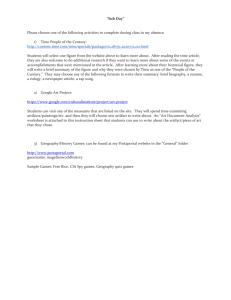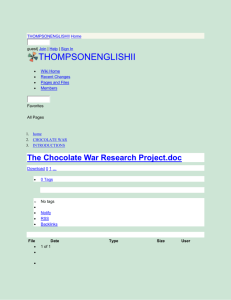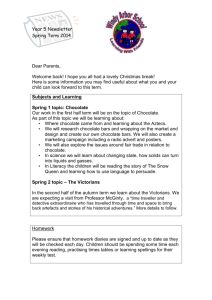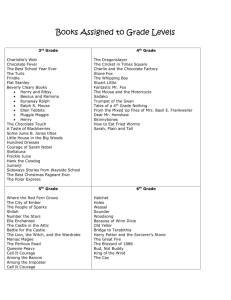Social Studies Lesson
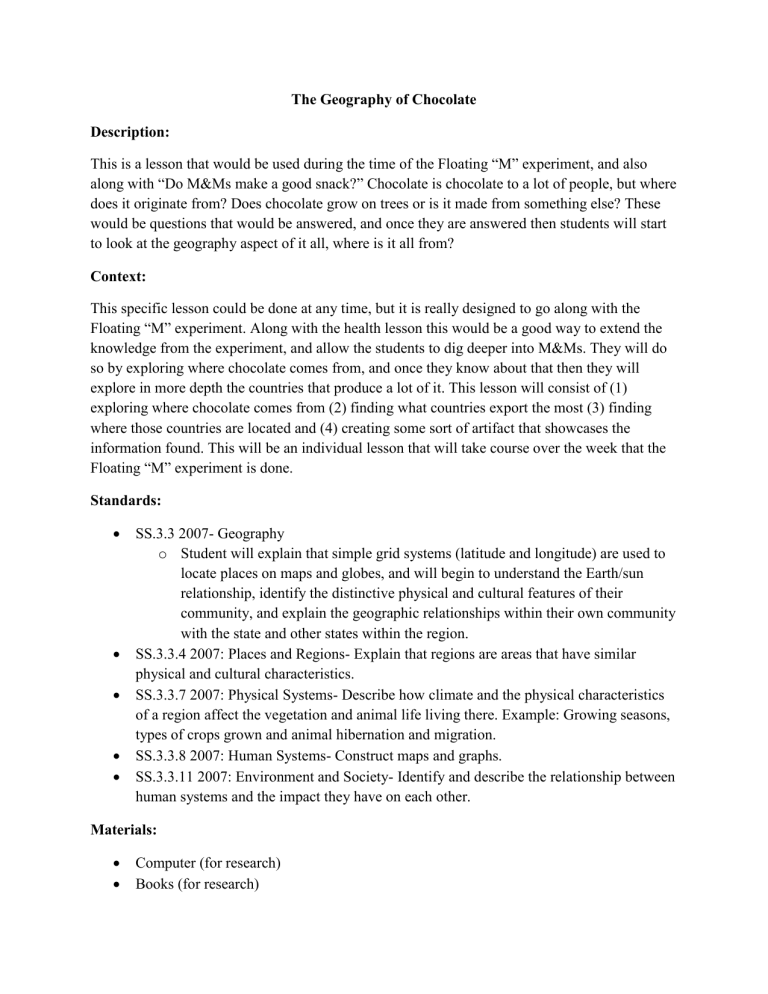
The Geography of Chocolate
Description:
This is a lesson that would be used during the time of the Floating “M” experiment, and also along with “Do M&Ms make a good snack?” Chocolate is chocolate to a lot of people, but where does it originate from? Does chocolate grow on trees or is it made from something else? These would be questions that would be answered, and once they are answered then students will start to look at the geography aspect of it all, where is it all from?
Context:
This specific lesson could be done at any time, but it is really designed to go along with the
Floating “M” experiment. Along with the health lesson this would be a good way to extend the knowledge from the experiment, and allow the students to dig deeper into M&Ms. They will do so by exploring where chocolate comes from, and once they know about that then they will explore in more depth the countries that produce a lot of it. This lesson will consist of (1) exploring where chocolate comes from (2) finding what countries export the most (3) finding where those countries are located and (4) creating some sort of artifact that showcases the information found. This will be an individual lesson that will take course over the week that the
Floating “M” experiment is done.
Standards:
SS.3.3 2007- Geography o Student will explain that simple grid systems (latitude and longitude) are used to locate places on maps and globes, and will begin to understand the Earth/sun relationship, identify the distinctive physical and cultural features of their community, and explain the geographic relationships within their own community with the state and other states within the region.
SS.3.3.4 2007: Places and Regions- Explain that regions are areas that have similar physical and cultural characteristics.
SS.3.3.7 2007: Physical Systems- Describe how climate and the physical characteristics of a region affect the vegetation and animal life living there. Example: Growing seasons, types of crops grown and animal hibernation and migration.
SS.3.3.8 2007: Human Systems- Construct maps and graphs.
SS.3.3.11 2007: Environment and Society- Identify and describe the relationship between human systems and the impact they have on each other.
Materials:
Computer (for research)
Books (for research)
Paper
Scissors
Markers
Colored pencils
Crayons
Glue sticks
Colored paper
Time:
The explanation of what will be happening will take about 15 minutes. The time that will be given to finish this project will be a week. Monday of the week will be when the project is explained, and then every day for the rest of the week the students will be given 30 minutes to work on their research and artifact.
Procedure:
Do a brief introduction on geography and why it is important to know
Explain what the project is o It is a chance to explore where chocolate is produced o It gives the students a chance to explore the world and learn where different countries are located o They should look up what countries export the most chocolate (after they do this they should pick just one country to focus on), then find where that country is located on a map, why they export so much chocolate (does it have to do with the climate), how is chocolate produced, and any other information they can find about that specific country that they chose o They will then create some sort of artifact that expresses the information that they have found out about their country and chocolate in general o The artifact could be a poster, book, PowerPoint, or anything that is approved of by the teacher
The students will be given a week to work on this project; after the first day they will receive 30 minutes daily to research and to work on their artifact
After the week is up there will be a gallery walk for everyone to look at what their peers did, and to see if they found out any information that they didn’t
Evaluation/Assessment:
The students will be assessed based off of what their final artifact is. Part of the assessment is to look at their artifact; was it colorful, creative, and organized well? The main form of assessment
will be to see if they included all of the information that they needed in/on their artifact. Does the information show that they understand where chocolate come from? Does it show that they know where the country is located on a map? And other questions similar to those. This is a better way than just testing them because the students got to choose what country they wanted to research, so it wouldn’t be fair to give a test that includes all the countries that export chocolate. It’s a fun and creative way for the students to show that they learned something.
Adaptations:
The Geography of Chocolate could be adapted for a student who has a learning disability in a couple of ways. One way would be to give them a partner who could do most of the research and the artifact, but allows the other student to contribute their ideas even if they aren’t capable of doing the research or writing on their own. If they aren’t good with writing (so putting the information on a poster or something like that) then their artifact could be an oral presentation of what they discovered. If the student has trouble staying focused then they could be paired with someone else as well to assist them in staying focused while researching. If the student has a more extreme learning disability then they could just look up what countries export chocolate and then just stop there. If the student needs more individualized attention they could still do this project, but it would probably be best if an aide came into help them so they can get it done without any problems.
What’s next?
What’s next with this lesson? It’s a good lesson to introduce geography and everything that it entails. By knowing what geography is and where countries are located it will assist them in the future when they have harder Social Studies and they need to know where countries are located.
At the end of it all this is just a fun and basic lesson that introduces concepts such as geography, climate, economics, and many other Social Studies related topics.
Reflection for Lesson:
I haven’t actually done this specific lesson, but during my time in ED 206 I did lessons that were similar to this in a way. During the time in that class the small group that I worked with chose two fruits (dragon fruit and kumquat) and for two of the Fridays that we spent with them we worked on the geography of the fruit. We would discuss why they were grown there, what the people who live there do with them, and other information regarding the geographical location of where they are grown. I found that because they chose the two fruits to research about that they were excited to learn about them and because they are tropical fruits they wanted to know where they came from. Even though in this lesson they don’t get to pick what they want to look at and research, I still think that chocolate is something that the majority of students like, and it would be an interesting food for them to look at in a geographical sense. Once they discover where chocolate comes from and where it’s from, and why it’s from there they will be amazed and want to dig deeper into the information. In ED 206 the group chose to make a book as their artifact, and by allowing them to do this it gave them ownership over all of the information that they found throughout the course of the semester. By making the assessment for this lesson an artifact where they could make a book, poster, etc. it allows them a chance to be creative and do what they want to show that they know what is going on and it doesn’t make them stressed thinking they will have something along the lines of a test. I also don’t think it would be fair because each group will view the information in their own way, and some might not even find the same information so it’s not really possible to generalize everything and give a test. Based off of how it went in ED 206, even though it was a small group of three students, I still think this would be successful with a full class.


